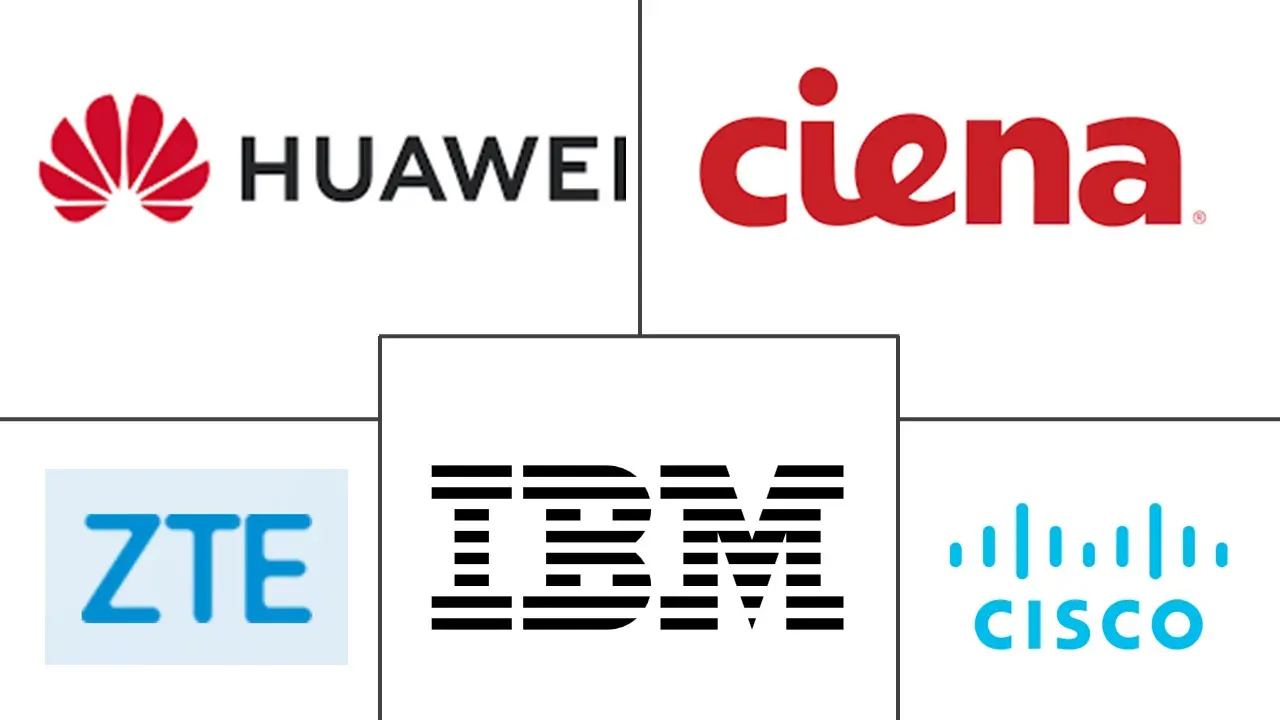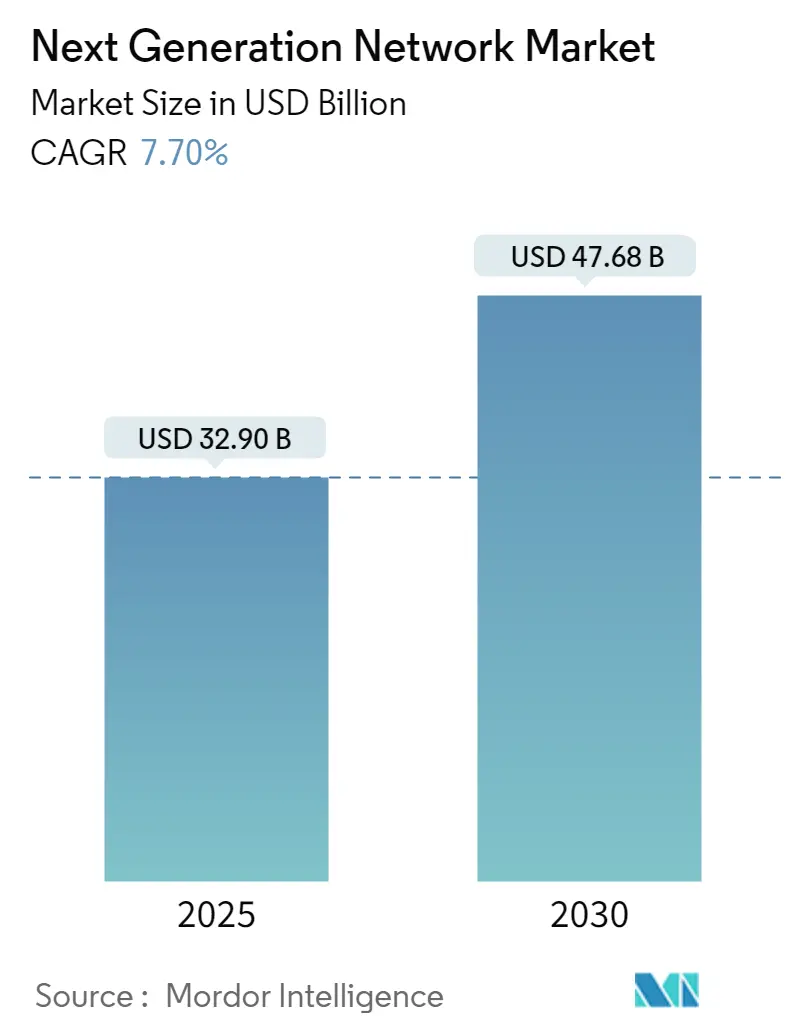
Next Generation Network Market Analysis
The Next Generation Network Market size is estimated at USD 32.90 billion in 2025, and is expected to reach USD 47.68 billion by 2030, at a CAGR of 7.7% during the forecast period (2025-2030).
The next-generation network landscape is experiencing a profound transformation driven by the convergence of advanced technologies and evolving communication needs. Network architectures are rapidly shifting from traditional hardware-centric approaches to more software-centric and programmable infrastructures, enabling greater flexibility and scalability. This evolution is particularly evident in the telecommunications sector, where, according to Ericsson's projections, global 5G mobile subscriptions are expected to reach 5.33 billion by 2029, highlighting the massive scale of network modernization underway. The integration of software-defined networking (SDN), network function virtualization (NFV), and cloud-native architectures is reshaping how networks are built and operated, enabling more efficient resource utilization and improved service delivery.
Industry collaboration and strategic partnerships have become crucial in accelerating innovation and deployment of next-generation networks in telecommunications. In December 2023, Huawei introduced its 5.5G Intelligent Packet Core Network offering to support intelligent 5G core networks, responding to the growing demand for 10 Gbps pipes and network intelligence. Similarly, in September 2023, Charter Communications partnered with Qualcomm Technologies to develop next-generation advanced Wi-Fi routers, bringing Wi-Fi 7 and 10 Gbps capabilities to consumers. These collaborations demonstrate the industry's commitment to pushing technological boundaries and creating more robust network infrastructures.
The network industry is witnessing significant investments in infrastructure modernization and digital transformation initiatives across regions. According to GSMA research, mobile data traffic in Europe is projected to triple over the next five years, driven by 4G migration in Central and Eastern Europe and increasing 5G coverage. This surge in data traffic is compelling operators to invest substantially in network infrastructure, with European operators projected to spend over Euro 198 billion on network advancement by 2030. The focus on infrastructure development is particularly evident in emerging markets, where governments and telecom operators are working to bridge the digital divide.
Digital transformation initiatives are gaining momentum across various sectors, with governments and enterprises increasingly recognizing the strategic importance of next-generation connectivity. In Saudi Arabia, the digital revolution is being fueled by Vision 2030, with over 340,000 professionals currently working in the digital, telecom, and information technology sectors. The transformation extends beyond traditional telecommunications, encompassing various industries such as healthcare, education, and financial services. This cross-sector digital evolution is driving the demand for more sophisticated network capabilities, including enhanced security features, lower latency, and improved reliability for mission-critical applications.
Next Generation Network Market Trends
Increasing Demand for High-Speed Services
The escalating demand for high-speed services is primarily driven by the exponential growth in data-intensive applications, emerging technologies, and evolving consumer expectations for seamless connectivity. The proliferation of bandwidth-intensive applications such as video streaming, cloud computing, augmented reality, and virtual reality has created an unprecedented need for faster and more reliable next-generation network infrastructure. This demand is further amplified by the rapid adoption of Internet of Things (IoT) devices and 5G technology, with Ericsson forecasting a substantial increase in 5G subscriptions from 1.57 billion in 2023 to 5.33 billion by 2029, indicating the massive scale of high-speed connectivity requirements in the coming years.
The transformation of traditional business operations and the increasing digitalization across industries are creating new use cases that demand enhanced network capabilities. For instance, in September 2023, the South Korean government launched the K-Network 2030 program to promote cooperation between public and private sectors in developing next-generation networking, satellite communications, and quantum communications, demonstrating the strategic importance of high-speed services. Additionally, telecom companies are actively working to meet these demands through innovative solutions, as evidenced by the partnership between NTT Corporation and Fujitsu in June 2023 to develop next-generation network services, utilizing advanced platforms like the "1FINITY Ultra Optical System" to support network expansion and deliver higher speeds. The integration of optical technology-based networks is particularly significant as it enables high-capacity communication while simultaneously addressing energy efficiency concerns by converting electric signals into optical ones.
The surge in remote work, digital entertainment, and smart device adoption has fundamentally altered network traffic patterns, necessitating more robust and faster network infrastructure. This is exemplified by recent industry developments, such as EE's collaboration with Qualcomm Technologies Inc. in September 2023 to roll out novel in-home hardware featuring Wi-Fi 7 platforms, aimed at providing best-in-class home connectivity throughout the UK. The initiative represents a broader industry trend where service providers are investing in next-generation networking technologies to meet the growing demand for high-speed services while ensuring future-proof network capabilities that can support emerging applications and services. This includes exploring examples of next-generation networks to enhance service delivery.
Segment Analysis: By Offering
Hardware Segment in Next Generation Network Market
The hardware segment continues to dominate the next-generation network market, holding approximately 40% market share in 2024. This significant market position is driven by the increasing demand for advanced network infrastructure components, including switches, routers, gateways, servers, and security devices designed to support emerging technologies such as IoT, 5G, and edge computing. The segment's strength is further reinforced by the growing need for hardware components that can handle higher bandwidth capabilities, enhanced network security, and faster data transmission requirements. Cloud computing NGN hardware forms the backbone of modern digital infrastructure, facilitating efficient and reliable communication across diverse networks. The demand is particularly strong in regions experiencing rapid digital transformation, where organizations are investing heavily in upgrading their network infrastructure to support bandwidth-intensive applications and ensure network security.
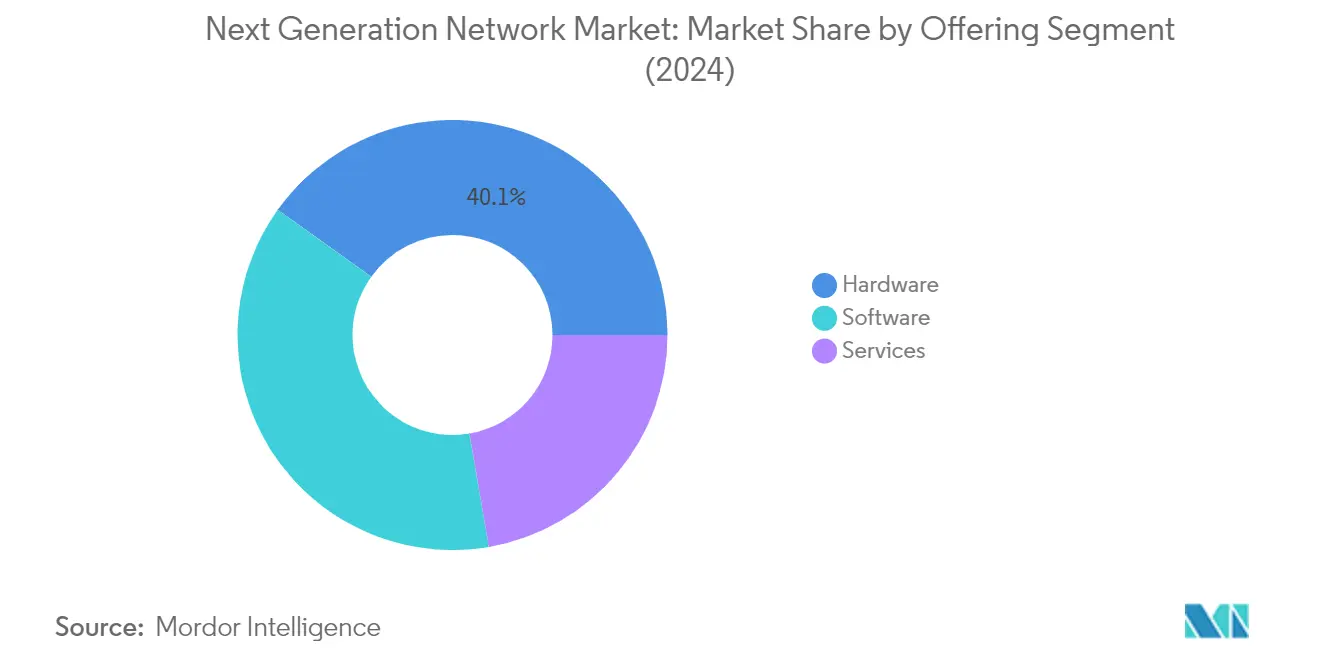
Services Segment in Next Generation Network Market
The next-generation network services segment is emerging as the fastest-growing segment in the next-generation network market, projected to grow at approximately 10% CAGR from 2024 to 2029. This remarkable growth is driven by the increasing complexity of network management and the rising demand for specialized expertise in deploying and maintaining next-generation network solutions. The segment's growth is further fueled by the adoption of advanced solutions utilizing technologies such as SDN, NFV, and cloud computing, which enable agile, scalable networks to be operated intelligently. Organizations are increasingly seeking providers offering reliable, innovative, and cost-effective NGN services, including Wi-Fi 6, SD-WAN, SASE, edge services, and private 5G that can support other IT transformations and enable businesses to meet their evolving connectivity needs.
Remaining Segments in Next Generation Network Market by Offering
The software segment plays a crucial role in the next-generation networks market, offering advanced solutions that leverage network function virtualization (NFV), software-defined networking (SDN), artificial intelligence (AI), and intent-based networking (IBN). This segment enables organizations to manage network resources efficiently, optimize performance, automate network provisioning and configuration, and enhance security measures. The software segment facilitates the transition from traditional hardware-centric approaches to more software-centric and programmable network architectures, allowing organizations to adapt to evolving business requirements and deliver superior user experiences in an increasingly connected world.
Segment Analysis: By End User
Telecom and Internet Service Providers Segment in Next Generation Network Market
The Telecom and Internet Service Providers segment holds a dominant position in the next-generation network market, commanding approximately 42% market share in 2024. This substantial market presence is driven by the increasing adoption of advanced networking technologies like 5G, cloud computing, and software-defined networking (SDN) among telecom operators. These providers are actively modernizing their network infrastructure to enhance performance, improve customer experience, and support emerging technologies like the Internet of Things (IoT) and edge computing. The segment's growth is further bolstered by significant investments in infrastructure upgrades, particularly in regions like North America and Asia-Pacific, where telecom companies are rapidly deploying 5G networks and implementing network monetization initiatives.
Telecom and ISP Growth Trajectory in Next Generation Network Market
The Telecom and Internet Service Providers segment is projected to experience the highest growth rate of approximately 8% during the forecast period 2024-2029. This accelerated growth is primarily attributed to the increasing demand for high-speed connectivity and advanced networking solutions. Telecom operators are increasingly focusing on network transformation initiatives, adopting cloud-native architectures, and implementing software-defined networking technologies to improve operational efficiency and service delivery. The segment's growth is further supported by strategic collaborations between telecom vendors and technology providers, aimed at developing innovative solutions for network optimization and service enhancement. The expansion of 5G networks and the growing need for enhanced mobile broadband services are also contributing significantly to this segment's rapid growth trajectory.
Remaining Segments in Next Generation Network Market by End User
The Government segment plays a crucial role in the next-generation network market, focusing on digital transformation initiatives and the development of secure, reliable communication infrastructure. Government agencies are increasingly adopting software-defined networks to build cost-effective wide-area networks and improve public service delivery. This segment is particularly active in implementing smart city projects and modernizing critical communication infrastructure. The adoption of next-generation network solutions in the government sector is driven by the need for enhanced security, improved operational efficiency, and better citizen services delivery, making it an integral part of the overall market landscape.
Next Generation Network Market Geography Segment Analysis
Next Generation Network Market in North America
The North American next-generation network market holds approximately 33% of the global market share in 2024, positioning itself as a crucial region in the global landscape. The region's dominance is primarily driven by rapid technological progress and the widespread adoption of advanced networking solutions in countries such as the United States and Canada. The market is characterized by substantial investments in infrastructure upgrades, particularly in 5G deployment and cloud-based solutions. The presence of major technology vendors and early adoption of innovative technologies like software-defined networking (SDN) and network function virtualization (NFV) further strengthens the region's position. North American enterprises are increasingly focusing on digital transformation initiatives, driving demand for next-generation network solutions. The region's robust telecommunications infrastructure, combined with growing enterprise requirements for high-speed connectivity and advanced network management capabilities, continues to fuel market growth. Additionally, government initiatives supporting digital infrastructure development and the increasing integration of AI and automation in network operations contribute to the market's expansion.
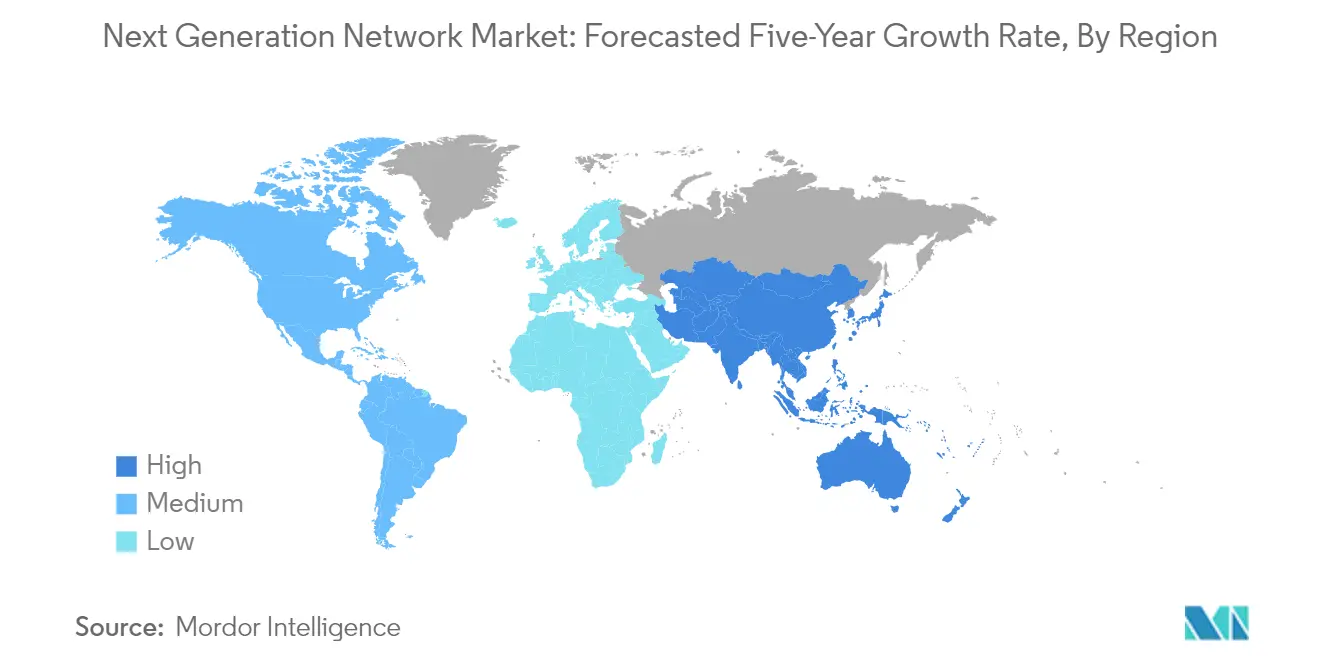
Next Generation Network Market in Europe
The European next-generation network market has demonstrated robust growth with approximately a 6% CAGR from 2019 to 2024, driven by increasing demand for high-speed connectivity and data-intensive applications. The region's market dynamics are shaped by strong investments in network infrastructure modernization and the rapid adoption of emerging technologies. European telecommunications operators are actively expanding their network capabilities to support evolving consumer and business needs, particularly in areas such as IoT deployment and cloud services integration. The market benefits from supportive regulatory frameworks and initiatives promoting digital transformation across industries. The region's focus on sustainable and energy-efficient network solutions has become a key differentiator in market development. European enterprises are increasingly embracing software-defined networking and cloud-native architectures to enhance operational efficiency and service delivery. The presence of established telecommunications vendors and ongoing investments in R&D continue to drive innovation in the next-generation network market.
Next Generation Network Market in Asia-Pacific
The Asia-Pacific next-generation network market is poised for exceptional growth with a projected CAGR of 8.64% from 2024 to 2029, marking it as the fastest-growing region globally. The market's expansion is fueled by rapid digitalization across various sectors and aggressive infrastructure development in countries like China, Japan, and South Korea. The region's telecommunications landscape is experiencing a significant transformation with the implementation of advanced network architectures and emerging technologies. Strong government support for digital initiatives and smart city projects is creating favorable conditions for market growth. The increasing internet penetration and growing adoption of cloud services are driving the demand for robust network infrastructure. The region's diverse market characteristics, ranging from mature telecommunications markets to emerging digital economies, present unique opportunities for network solution providers. The convergence of traditional telecommunications with emerging technologies like AI and IoT is reshaping the market landscape, particularly in Japan, where the next-generation network is advancing rapidly.
Next Generation Network Market in Latin America
The Latin American next-generation network market is experiencing significant transformation driven by increasing demand for high-speed internet and rising adoption of digital services. The region's telecommunications sector is undergoing substantial modernization as service providers upgrade their infrastructure to support emerging technologies and applications. Market growth is supported by increasing smartphone penetration and expanding digital services across various sectors, including finance, healthcare, and education. The deployment of advanced networking technologies is enabling improved connectivity solutions for both urban and rural areas. Telecommunications operators in the region are focusing on network modernization to support the growing demand for data-intensive applications and services. The market is characterized by increasing investments in infrastructure development and the adoption of cloud-based solutions. The region's evolving digital ecosystem and growing emphasis on enterprise digital transformation are creating new opportunities for market expansion.
Next Generation Network Market in Middle East & Africa
The Middle East & African next-generation network market is witnessing steady growth driven by rapid digital transformation across various sectors, including telecommunications, finance, and government services. The region's market is characterized by increasing investments in network infrastructure modernization and the adoption of advanced technologies. Telecommunications operators are actively expanding their network capabilities to support the growing demand for high-speed connectivity and digital services. The market is benefiting from government initiatives promoting digital transformation and smart city development. Enterprise adoption of next-generation network solutions is increasing as businesses seek to enhance their operational efficiency and service delivery capabilities. The region's growing focus on digital innovation and increasing internet penetration are creating new opportunities for market growth. The deployment of advanced network technologies is enabling improved connectivity solutions and supporting the region's digital evolution.
Next Generation Network Industry Overview
Top Companies in Next Generation Network Market
The next-generation network market features prominent players like Cisco Systems, Huawei Technologies, ZTE Corporation, IBM Corporation, Samsung Electronics, NEC Corporation, Nokia Corporation, and Ericsson, who are driving innovation through continuous R&D investments. These companies are focusing on developing advanced solutions incorporating software-defined networking, network function virtualization, artificial intelligence, and cloud-native architectures to enhance network flexibility and efficiency. Strategic collaborations and partnerships, particularly in 5G deployment and cloud integration, have become crucial for market expansion. Companies are increasingly emphasizing sustainability and energy efficiency in their network solutions while simultaneously working on improving network automation and orchestration capabilities. The market is witnessing a shift towards integrated solutions that combine hardware, software, and services to provide end-to-end network transformation capabilities, with players investing heavily in developing expertise across multiple domains, including cloud computing, edge computing, and network security.
Dynamic Market Structure Drives Industry Evolution
The next-generation network market exhibits a complex competitive structure characterized by both global technology conglomerates and specialized networking solution providers. Global players leverage their extensive R&D capabilities, broad product portfolios, and strong financial resources to maintain market leadership, while regional specialists focus on niche solutions and local market expertise. The market is experiencing ongoing consolidation through strategic acquisitions and partnerships, particularly in emerging technology areas such as 5G infrastructure, cloud-native solutions, and network automation platforms. Companies are increasingly pursuing vertical integration strategies to offer comprehensive solutions, from network equipment to software and services.
The competitive landscape is further shaped by the presence of telecom equipment manufacturers, software solution providers, and system integrators, each bringing unique capabilities to the network industry. Market participants are actively engaging in ecosystem development through partnerships with cloud providers, technology vendors, and system integrators to enhance their solution offerings. The industry is witnessing increased collaboration between established players and innovative startups, particularly in areas such as network virtualization, artificial intelligence, and edge computing solutions. Regional players are gaining prominence by focusing on specific market segments and developing solutions tailored to local requirements and regulations.
Innovation and Adaptability Drive Market Success
Success in the next-generation networks market increasingly depends on companies' ability to innovate while maintaining operational efficiency and service quality. Incumbent players are focusing on expanding their software and services capabilities, investing in emerging technologies, and developing more flexible deployment models to maintain their market position. Companies are also emphasizing customer experience and service customization capabilities while building strong partnerships with technology providers and system integrators. The ability to provide end-to-end solutions, including hardware, software, and services, while maintaining compatibility with existing infrastructure, has become crucial for market success.
Market contenders are gaining ground by focusing on specific market segments, developing innovative solutions for emerging use cases, and building strong relationships with local customers and partners. The increasing importance of network security, energy efficiency, and sustainability is creating opportunities for specialized solution providers to differentiate themselves. Companies are also investing in developing expertise in key areas such as artificial intelligence, machine learning, and automation to enhance their competitive position. The regulatory environment, particularly regarding data privacy, security, and environmental sustainability, is becoming increasingly important in shaping competitive strategies and market dynamics.
Next Generation Network Market Leaders
-
Cisco Systems, Inc.
-
Huawei Technologies Co., Ltd.
-
ZTE Corporation
-
Ciena Corporation
-
IBM Corporation
- *Disclaimer: Major Players sorted in no particular order
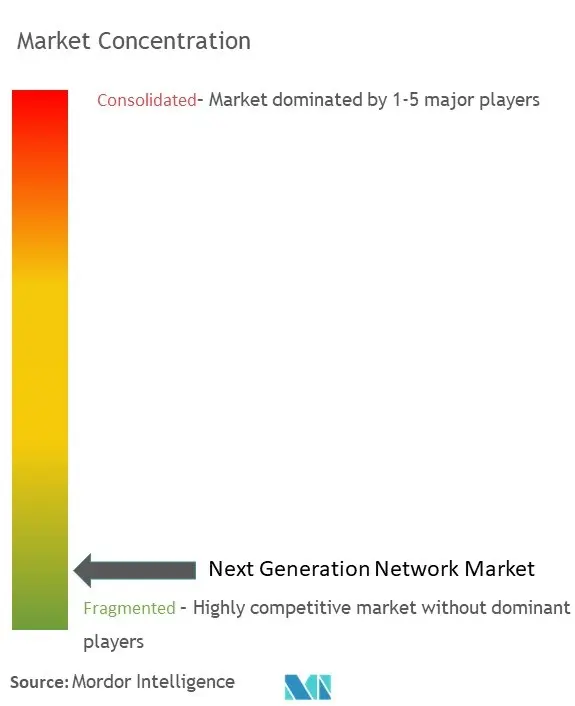
Next Generation Network Market News
- February 2024 - Schneider Electric, delivering next-generation, open automation infrastructure in collaboration with the technology companies Intel and Red Hat, released a Distributed Control Node (DCN) software framework. An expansion of Schneider Electric's EcoStruxure Automation Expert, this new framework allows industrial companies to move to a software-defined, plug-and-produce solution, enabling them to augment their operations, ensure quality, minimize complexity, and optimize costs.
- September 2023 - Charter Communications Inc. collaborated with Qualcomm Technologies Inc. to deliver the next-generation advanced Wi-Fi router that will bring Wi-Fi 7 and 10 Gbps Wi-Fi capabilities to Spectrum Internet users, helping support and enhance the converged connectivity experience for residential and small and medium-sized business customers. This will support the delivery of new experiences, such as fully immersive, ultra-low latency VR, and aligns with the company's plan to enable multi-gig wireless connectivity across its entire footprint.
Next Generation Network Market Report - Table of Contents
1. INTRODUCTION
- 1.1 Study Assumptions and Market Definition
- 1.2 Scope of the Study
2. RESEARCH METHODOLOGY
3. EXECUTIVE SUMMARY
4. MARKET INSIGHTS
- 4.1 Market Overview
-
4.2 Market Drivers
- 4.2.1 Increasing Demand for High-Speed Services
-
4.3 Market Restraints
- 4.3.1 High Costs Related to the Infrastructure
-
4.4 Industry Attractiveness - Porter's Five Forces Analysis
- 4.4.1 Threat of New Entrants
- 4.4.2 Bargaining Power of Buyers/Consumers
- 4.4.3 Bargaining Power of Suppliers
- 4.4.4 Threat of Substitute Products
- 4.4.5 Intensity of Competitive Rivalry
- 4.5 Impact of COVID-19 on the Next-generation Network Market
5. MARKET SEGMENTATION
-
5.1 By Offering
- 5.1.1 Hardware
- 5.1.2 Software
- 5.1.3 Services
-
5.2 By End User
- 5.2.1 Telecom and Internet Service Providers
- 5.2.2 Government
- 5.2.3 Other End-users
-
5.3 By Geography
- 5.3.1 North America
- 5.3.2 Europe
- 5.3.3 Asia-Pacific
- 5.3.4 Latin America
- 5.3.5 Middle East and Africa
6. COMPETITIVE LANDSCAPE
-
6.1 Company Profiles*
- 6.1.1 Cisco Systems, Inc.
- 6.1.2 Huawei Technologies Co., Ltd.
- 6.1.3 ZTE Corporation
- 6.1.4 Ciena Corporation
- 6.1.5 IBM Corporation
- 6.1.6 Samsung Electronics Co., Ltd.
- 6.1.7 NEC Corporation
- 6.1.8 Juniper Networks, Inc.
- 6.1.9 Nokia Corporation
- 6.1.10 Telefonaktiebolaget LM Ericsson
7. INVESTMENT ANALYSIS
8. FUTURE OF THE MARKET
Next Generation Network Industry Segmentation
The next-generation network market is defined based on the revenues generated from the sale of hardware, software, and services by key vendors across the world.
The next-generation network market is segmented by offering (hardware, software, and services), end user (telecom and internet service providers, government, and other end users), and geography (North America, Europe, Asia-Pacific, Latin America, and Middle East and Africa). The report offers market forecasts and size in value (USD) for all the above segments.
| By Offering | Hardware |
| Software | |
| Services | |
| By End User | Telecom and Internet Service Providers |
| Government | |
| Other End-users | |
| By Geography | North America |
| Europe | |
| Asia-Pacific | |
| Latin America | |
| Middle East and Africa |
Next Generation Network Market Research FAQs
How big is the Next Generation Network Market?
The Next Generation Network Market size is expected to reach USD 32.90 billion in 2025 and grow at a CAGR of 7.70% to reach USD 47.68 billion by 2030.
What is the current Next Generation Network Market size?
In 2025, the Next Generation Network Market size is expected to reach USD 32.90 billion.
Who are the key players in Next Generation Network Market?
Cisco Systems, Inc., Huawei Technologies Co., Ltd., ZTE Corporation, Ciena Corporation and IBM Corporation are the major companies operating in the Next Generation Network Market.
Which is the fastest growing region in Next Generation Network Market?
Asia Pacific is estimated to grow at the highest CAGR over the forecast period (2025-2030).
Which region has the biggest share in Next Generation Network Market?
In 2025, the Asia Pacific accounts for the largest market share in Next Generation Network Market.
What years does this Next Generation Network Market cover, and what was the market size in 2024?
In 2024, the Next Generation Network Market size was estimated at USD 30.37 billion. The report covers the Next Generation Network Market historical market size for years: 2019, 2020, 2021, 2022, 2023 and 2024. The report also forecasts the Next Generation Network Market size for years: 2025, 2026, 2027, 2028, 2029 and 2030.
Our Best Selling Reports
Next Generation Network Market Research
Mordor Intelligence offers a comprehensive analysis of the next generation network market. We leverage our extensive expertise in network industry research and consulting. Our latest report examines the evolution of network trends and next generation connectivity. It focuses particularly on NGN implementation across regions, including network generations used in America and current network infrastructure developments in Japan. The analysis covers next generation network services and emerging technologies that are reshaping the telecommunications landscape.
Stakeholders gain valuable insights through our detailed examination of next-generation network technologies and their impact on global communications infrastructure. The report addresses crucial aspects of next generation networks in telecommunication. It includes a detailed analysis of network trends and next generation LAN developments. For convenient access, our comprehensive insights are available as an easy-to-download report PDF. It features in-depth analysis of NGN in telecom applications and emerging next generation wireless network technologies. The report provides strategic intelligence for businesses navigating the rapidly evolving next gen networking landscape.

